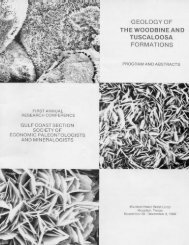Program and Abstracts - Gulf Coast Section SEPM
Program and Abstracts - Gulf Coast Section SEPM
Program and Abstracts - Gulf Coast Section SEPM
Create successful ePaper yourself
Turn your PDF publications into a flip-book with our unique Google optimized e-Paper software.
Footprint Suppression Applied to Legacy Seismic Data Volumes<br />
Davogustto, Oswaldo<br />
University of Oklahoma<br />
100 E. Boyd St., Suite 710<br />
Norman, Oklahoma 73019<br />
email: dellpi@ou.edu<br />
Marfurt, Kurt<br />
University of Oklahoma<br />
100 E. Boyd St., Suite 710<br />
Norman, Oklahoma 73019<br />
Acquisition footprint often poses a major problem<br />
for 3D seismic data interpretation. Ideally,<br />
footprint from acquisition is h<strong>and</strong>led at the processing<br />
shop through more careful attention to trace balancing<br />
statics, noise reduction, <strong>and</strong> velocity analysis (Hill et<br />
al., 1999; Gülünay, 2000). Such reprocessing is not<br />
feasible on many legacy data volumes where the<br />
prestack data cannot be found or no longer exists. Seismic<br />
attributes often provide an effective means of<br />
delineating subtle geological features of interest such<br />
as channels, small faults, <strong>and</strong> f ractures but can also<br />
enhance acquisition footprint. For this reason attributes<br />
can be used to both design <strong>and</strong> evaluate the effectiveness<br />
of alternative footprint suppression workflows.<br />
Abstract<br />
In this work we review, apply, <strong>and</strong> evaluate the<br />
three most popular footprint suppression workflows:<br />
structure-oriented filtering, k x -k y filtering, <strong>and</strong> limited<br />
data reconstruction using singular value decomposition.<br />
We both characterize acquisition footprint <strong>and</strong><br />
evaluate its suppression by its attribute response<br />
through application to legacy data volumes acquired<br />
over the shelf of the <strong>Gulf</strong> of Mexico, the Central Basin<br />
Platform of Texas, the Delaware Basin of New Mexico,<br />
<strong>and</strong> the Anadarko Basin of Oklahoma. There is no silver<br />
bullet; in most cases it is useful to combine<br />
structure-oriented filtering <strong>and</strong> k x -k y filtering workflows<br />
as an attempt to r emove acquisition footprint<br />
from legacy data volumes.<br />
Attributes: New Views on Seismic Imaging—Their Use in Exploration <strong>and</strong> Production 1
















